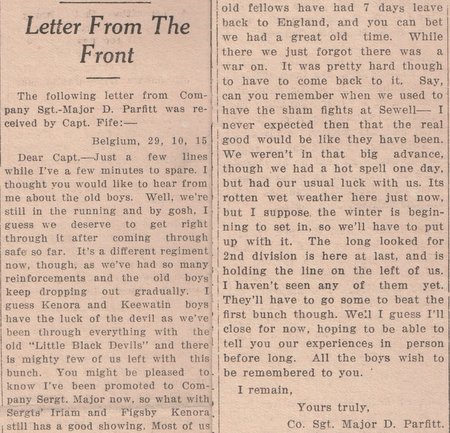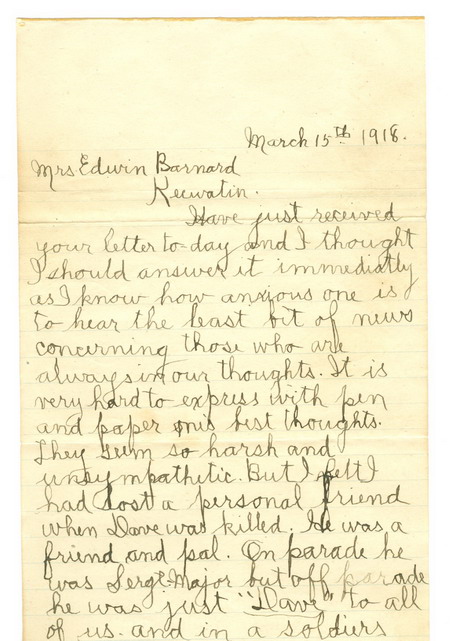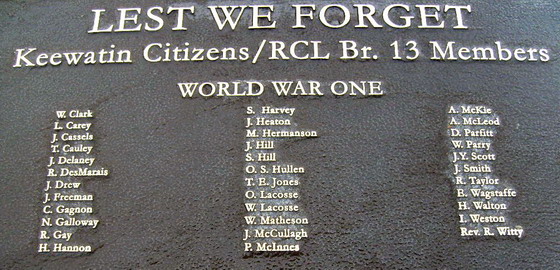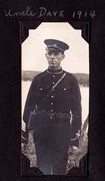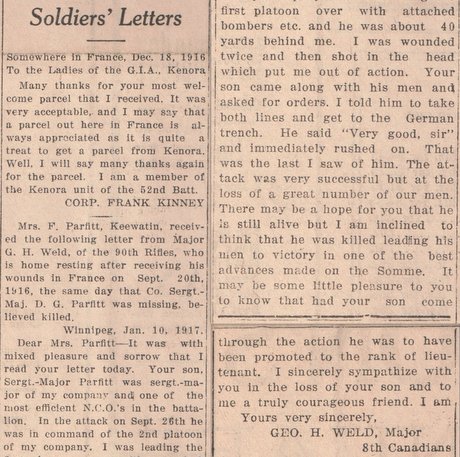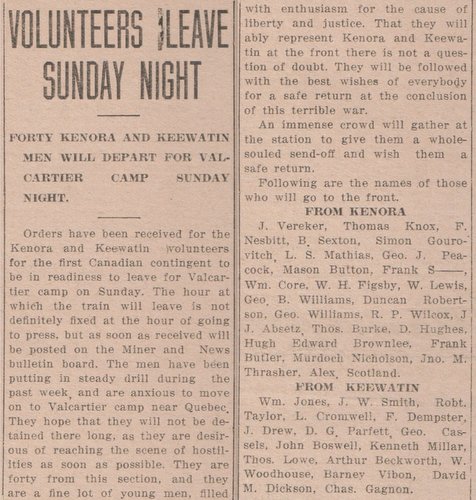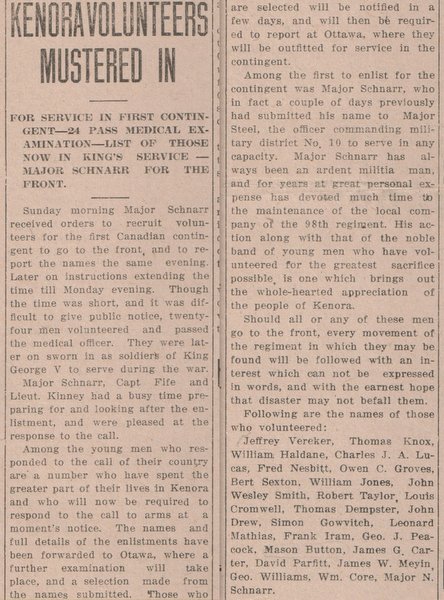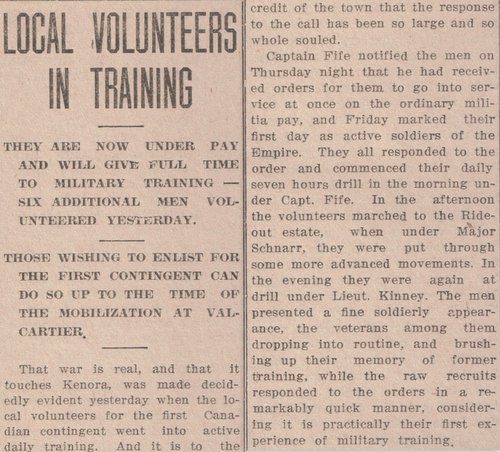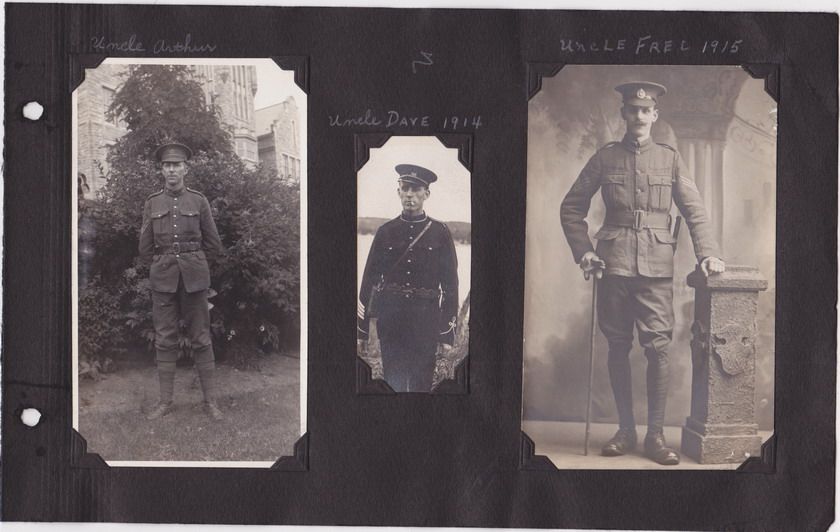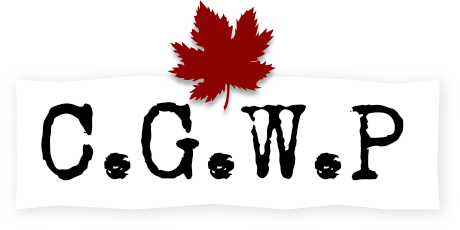
Sergeant-Major David George Parfitt
PERSONAL INFORMATION
MILITARY INFORMATION
- Sergeant, 8th Battalion, Infantry (Army).
- Warrant Officer II, 8th Battalion, Infantry (Army).
- Sergeant-Major, 8th Battalion, Infantry (Army).
Images
RESEARCH INFORMATION
The Somme Offensive was a series of battles that lasted from July to November 1916 and resulted in enormous losses for both sides. The Canadian Corps moved to the Somme area in late August and their first major engagement was in September. Company Sergeant Major David George Parfitt of Keewatin, Ontario was one of 24,000 casualties suffered by the Canadians in their 2-1/2 months at the Somme.
Early life and enlistment
David was born in Friern Barnet, London, England, the son of Fred Parfitt and Elizabeth Woodhouse. Fred and Elizabeth were married in London on 31 December 1881 and they had seven children, four sons (Frederick, William, David and Arthur) and three daughters (Catherine, Agnes and Minnie). David, the second youngest, was born on 4 July 1891. For both the 1891 and 1901 censuses the family was living in London and Fred was working as a police constable. By 1910 they had moved to Bradford-on-Avon in Wiltshire, where some of Fred’s family lived. David found work as an assistant chauffeur and he joined the Church Lads’ Brigade, becoming senior sergeant. His younger brother Arthur and cousin Henry Walton were also members. In 1910, when they were just 18 and 15, David and Arthur immigrated to Canada. They arrived in May on the Tunisian, their destination listed as Keewatin, Ontario where an uncle was living. A year later Fred, Elizabeth, Catherine and William also immigrated and when the 1911 census was taken the family was living on Superior Street in Keewatin.
The militia was very popular with young men at the time and David joined the local unit, the 98th regiment, which was based in the neighbouring town of Kenora. Britain declared war on 4 August 1914 and a few days later the 98th began training full time. Volunteers for the 1st Canadian Contingent were told to enroll with their local militia then proceed to Valcartier, Quebec, an area northwest of Quebec City that would become the site of a large military camp. On 23 August, along with about forty other local recruits, David boarded a special troop train headed to Quebec. Thousands of people turned out at the Kenora train station that day to see the men off and wish them well. At Valcartier they underwent training, medical tests and inoculations and David’s medical exam on 27 August tells us he was 5’10-1/2” tall with brown hair and grey eyes. He was found fit for service and on 21 September he enlisted with the 8th Battalion (90th Winnipeg Rifles), a unit made up of recruits from Manitoba and northwestern Ontario. The following day he was promoted to Sergeant. In early October the battalion embarked for England with the 1st Contingent, leaving from Quebec City on the SS Franconia. They were part of a convoy of 32 transport ships protected by a Royal Navy escort because of the danger from German submarines. The convoy arrived safely in Plymouth, England on 14 October.
1914-15
The Canadians trained on Salisbury Plain in southern England for several months and when the men were given leave for the holiday season many of them spent time with family in the UK. After another month of training the 8th Battalion was sent to France in February 1915, as part of the 2nd Infantry Brigade, 1st Canadian Division. For the first few weeks they were based south of Ypres, in the area between Hazebrouck and Armentières, where they were introduced to trench warfare. In April the Canadian units were moved north to the Ypres Salient, to a section of the front line near Gravenstafel. The first large-scale use of poison gas by the Germans took place on 22 April at Gravenstafel Ridge and the 8th Battalion was hit by it on 24 April, the start of the Battle of St. Julien. There were heavy casualties from the poison and in the fighting that followed as German infantry advanced behind the cloud of gas. The Canadians held the line until they were relieved on 25 April, suffering 6,000 casualties over the two days.
In early May the 8th Battalion moved back into France and on 17 May they began to march south to take part in the Battle of Festubert. It rained heavily all day and due to a lack of billets most of the men spent that night in an open field. David became ill with dysentery and on 19 May he was sick enough to be evacuated to England. Nine days later he was back in France recovering at a convalescent centre. When he rejoined his unit in mid-June they had just been through the fighting at Givenchy. At the end of the month the 8th Battalion moved back to Belgium where the Canadians would spend almost a year holding a section of the front line south of Ypres. There were no major operations for them over the fall and winter but the policy was one of aggressive activity against the Germans, including raids on their trenches. The 8th Battalion had regular rotations in the front lines and the men also spent time in work parties, digging and repairing trenches and dugouts, going on patrols and training.
1915-16
On 27 September 1915 David was promoted to Company Sergeant Major with the rank of Warrant Officer Class II. He had seven days leave in the UK that fall and again in March 1916. In April he was away for a month due to illness and he rejoined his unit in mid-May. They were back in the Ypres Salient and at the end of the month they moved into the trenches near a hill called Mount Sorrel. The Battle of Mount Sorrel started on the morning of 2 June with a massive bombardment by the Germans followed by the explosion of underground mines. Following the barrage German infantry attacked and captured the hill and nearby areas. The 8th Battalion was relieved from the line on the night of 5-6 June then went back in on 12 June to take part in the final counter-attack. Most of the lost areas were recaptured and the two-week battle ended with almost no change to the front lines but at a cost of 8,000 Canadian casualties.
The Somme Offensive started two weeks later, on 1 July 1916, and the Canadian Corps began to move to the Somme area in August. The 8th Battalion arrived near Albert on 2 September and they had a couple of rotations in the front and support trenches. German artillery was very active and even before their first battle on 15 September the Canadians suffered over 2,000 casualties. The first operation for the 8th Battalion was the Battle of Thiepval Ridge, which took place between the villages of Thiepval and Courcelette. The assault began at 12:35 pm on 26 September and David’s unit, on the far left flank of the Canadian Corps, advanced over the highest part of the ridge against heavy machine gun and artillery fire. The battalion reached its objectives, Zollern and Hessian trenches, but they were not completely secured until the following day. The men were relieved on 28 September and the war diary for the 8th Battalion recorded 446 casualties in the three days of fighting. David was one of the fallen, missing in action on the first day of the battle, 26 September, while leading his men in the advance.
Remembered
David was declared missing in action and presumed killed, with his final resting place unknown. In March 2015 research by R. Laughton determined that he is buried in Regina Trench Cemetery in Grandcourt, France, marked as an Unknown Sergeant Major of the 8th Battalion.
David is commemorated on the Vimy Memorial in France and in Keewatin on the Cenotaph, the St. James Anglican Church plaque and the Lake of the Woods Milling Company Roll of Honour. His name is also engraved on a marker erected by Gold Hill and Minnetonka Lodges of Kenora and Keewatin. The marker, in Lake of the Woods Cemetery, is in memory of lodge members who died in the Great War. He is also commemorated on the war memorial at Holy Trinity Church in Bradford-on-Avon, Wiltshire, and on page 145 of Canada’s First World War Book of Remembrance, on display in the Peace Tower on Parliament Hill in Ottawa. At a ceremony in Keewatin on 4 August 1919 his family was presented with a medal in honour of his service. It was inscribed: He fought for freedom and honour. In commemoration of D. Parfitt who made the supreme sacrifice in the Great War 1914-1918.
All three of David’s brothers served in the war: Frederick with the British army, William with the Canadian Navy and Corporal Arthur Parfitt with the CEF in Canada. Their cousin Private Henry Walton was killed at the Somme on 15 September 1916 while serving with the 27th (City of Winnipeg) Battalion.
David’s mother passed away in 1932 and his father in 1942. They are both buried in Lake of the Woods Cemetery in Kenora. Also buried there are his brothers William (1886-1963) and Arthur (1894-1977), and his sisters Catherine Barnard (1884-1972) and Minnie Balchin (1890-1980).
[Sergeant Army Canadian Infantry 8th Battalion D Warrant Officer Class II Army Canadian Infantry 8th Battalion D Company Sergeant-Major Army Canadian Infantry 8th Battalion D ]

